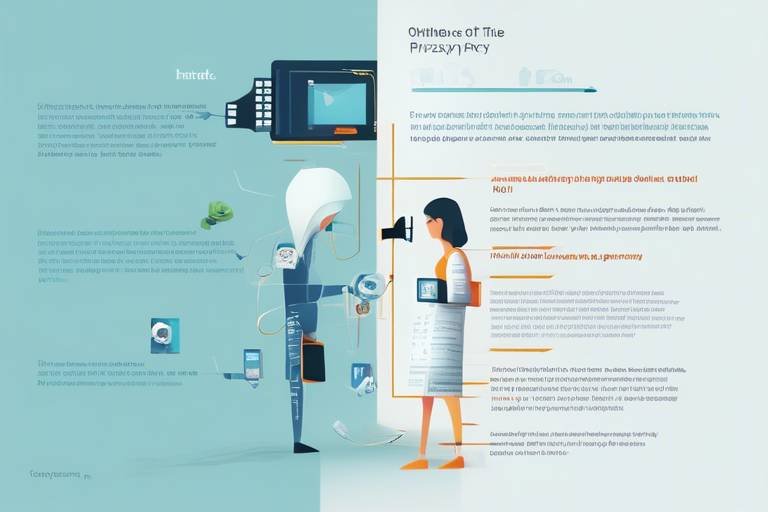Future Trends in Cybersecurity Awareness and Training
The digital landscape is evolving at a breakneck pace, and with it, the threats to our cybersecurity are becoming increasingly sophisticated. Organizations are no longer just focusing on firewalls and antivirus software; they are now recognizing that the **human element** is one of the most significant vulnerabilities in their security posture. This article explores emerging trends in cybersecurity awareness and training, highlighting innovative strategies, technologies, and methodologies that organizations can adopt to enhance their security awareness and preparedness in an ever-evolving digital landscape.
In today’s world, it’s clear that the **human factor** plays a pivotal role in cybersecurity. Organizations are increasingly shifting their training programs to foster a culture of security awareness among employees. This means that rather than viewing cybersecurity as solely the responsibility of the IT department, all employees are encouraged to take part in protecting sensitive information. By cultivating an environment where everyone feels empowered to recognize potential threats, organizations can significantly reduce the risk of data breaches. Imagine a ship where every crew member is vigilant; that’s the level of awareness organizations aim for.
Ever felt bored in a training session? You’re not alone! That’s why gamification is becoming a popular method for engaging employees in cybersecurity training. By incorporating game-like elements—such as points, levels, and rewards—organizations can transform mundane learning into an interactive and enjoyable experience. This approach not only boosts engagement but also enhances retention and application of security practices. Think of it as turning a tedious chore into a fun game; who wouldn’t want to play while learning how to protect their organization?
Artificial intelligence (AI) and machine learning are revolutionizing cybersecurity training by providing **personalized learning experiences**. These technologies can analyze user behavior and adapt training content to address specific vulnerabilities and knowledge gaps. For instance, if an employee frequently struggles with phishing simulations, the training can automatically adjust to provide more targeted exercises. This tailored approach ensures that every employee receives the training they truly need, making it not just effective but also efficient. It’s like having a personal trainer for your cybersecurity skills!
In our fast-paced world, attention spans are dwindling, making **microlearning** a vital component of effective cybersecurity training. This method delivers content in small, digestible segments, allowing employees to absorb and retain information more effectively. Imagine learning a new language by focusing on one word at a time rather than overwhelming yourself with an entire dictionary. Microlearning ensures continuous learning and reinforcement of key concepts, making it easier for employees to stay informed about the latest threats and best practices.
Nothing beats hands-on experience, especially when it comes to cybersecurity. Utilizing **real-world simulations** helps employees experience potential cyber threats in a controlled environment. This practical approach enhances skills and prepares staff to respond effectively to actual incidents. For example, organizations can create simulated phishing attacks to see how employees react, providing valuable lessons in a safe setting. It’s like a fire drill for your digital safety—better to prepare now than to face the flames later!
Cyber threats are constantly evolving, necessitating ongoing education. Organizations are prioritizing **continuous learning initiatives** to ensure that employees are equipped with the latest knowledge and skills to combat emerging threats. This could involve regular updates to training materials, workshops, or even webinars featuring cybersecurity experts. Just like a garden needs regular tending to flourish, so does cybersecurity knowledge in an organization.
With increasing regulations around data protection, **compliance training** is becoming essential. Organizations are integrating compliance-focused modules into their cybersecurity training programs to ensure adherence to legal requirements and industry standards. This not only protects sensitive data but also helps avoid hefty fines. Think of compliance training as the rules of the road; understanding them keeps everyone safe from potential accidents.
As remote work becomes the norm, organizations are adopting **online training solutions**. Virtual platforms provide flexibility and accessibility, allowing employees to engage in cybersecurity training from any location. This adaptability is crucial, especially when considering that security awareness should never take a back seat, regardless of where employees are working. It’s like having a gym membership that allows you to work out anywhere—convenience is key!
Creating **collaborative learning environments** encourages knowledge sharing among employees. Organizations are fostering teamwork in cybersecurity training, enabling staff to learn from each other's experiences and insights. This collective approach not only strengthens the overall security culture but also builds a sense of community. Think of it as a potluck dinner; everyone brings something to the table, and together, they create a feast of knowledge!
- What is the importance of cybersecurity training? Cybersecurity training is essential to equip employees with the knowledge and skills to recognize and respond to cyber threats, thereby protecting sensitive information.
- How can gamification improve cybersecurity training? Gamification makes learning more engaging and enjoyable, improving retention and application of security practices through interactive elements.
- Why is continuous learning necessary in cybersecurity? Continuous learning is crucial because cyber threats are constantly evolving, and employees need to stay updated on the latest tactics and defenses.
- What role does AI play in cybersecurity training? AI can personalize training experiences by analyzing user behavior and adapting content to address specific vulnerabilities and knowledge gaps.

Increased Focus on Human-Centric Security
In today's digital age, the importance of human behavior in cybersecurity cannot be overstated. Organizations are waking up to the reality that even the most sophisticated security systems can be undermined by a single human error. Think about it: a well-crafted phishing email can trick even the most vigilant employee, leading to significant data breaches. Therefore, a shift towards human-centric security is not just a trend; it's a necessity. Companies are now investing in programs that not only teach employees about potential threats but also engage them in a culture of security awareness.
Imagine a workplace where every employee, from the intern to the CEO, understands their role in safeguarding sensitive information. This is the vision that organizations are striving for. By fostering a culture of security awareness, companies can empower their employees to recognize threats and respond appropriately. Training programs are being designed to highlight the critical role that each individual plays in maintaining security. This approach goes beyond mere compliance; it encourages a proactive mindset among employees.
To achieve this transformation, organizations are implementing various strategies:
- Interactive Workshops: These sessions allow employees to engage in discussions and share experiences related to cybersecurity, making the learning process more relatable.
- Regular Updates: Keeping employees informed about the latest threats and trends ensures that they remain vigilant and aware of potential risks.
- Feedback Mechanisms: Encouraging employees to provide feedback on training programs can help organizations refine their approaches and make the content more relevant.
Furthermore, organizations are recognizing that training should not be a one-time event but rather an ongoing process. Just like the ever-evolving landscape of cyber threats, the training must adapt and grow. By integrating human-centric security into the organizational culture, companies can create a robust defense against cyber threats. This means not only implementing training programs but also encouraging open communication about security concerns and incidents. When employees feel comfortable discussing potential vulnerabilities, it fosters a sense of community and shared responsibility.
In conclusion, the increased focus on human-centric security is a game-changer in the world of cybersecurity. By investing in training that emphasizes the role of employees in protecting sensitive information, organizations can build a resilient security posture. As we move forward, the challenge will be to maintain this momentum and continuously evolve training programs to meet the changing landscape of cyber threats.

Gamification of Training Programs
In today's fast-paced digital world, traditional training methods often fall flat. Employees can feel overwhelmed by lengthy manuals and monotonous lectures, leading to disengagement and poor retention of crucial information. Enter gamification, a revolutionary approach that transforms cybersecurity training into an engaging and interactive experience. By incorporating game-like elements into training programs, organizations can effectively capture employees' attention and enhance their learning outcomes.
So, what exactly does gamification entail? It’s not just about slapping a leaderboard on a training module and calling it a day. Instead, it involves creating a rich, immersive environment where employees can earn points, unlock achievements, and compete against colleagues in a fun yet educational setting. This approach not only makes learning enjoyable but also fosters a sense of accomplishment and motivation among participants.
For instance, imagine a scenario where employees navigate through a virtual world, solving puzzles related to identifying phishing attempts or securing sensitive data. Each challenge they conquer could earn them badges or rewards, reinforcing their knowledge and encouraging them to apply what they’ve learned in real-world situations. This method is akin to leveling up in a video game, where each stage presents new challenges and learning opportunities.
Moreover, gamification can significantly improve retention rates. Research shows that people are more likely to remember information that they have actively engaged with, rather than passively consumed. By turning training into a game, organizations can create memorable experiences that stick with employees long after the training session has ended. According to a study by the Research Institute of America, gamified learning can lead to a remarkable 60% increase in engagement and retention compared to traditional methods.
To illustrate the effectiveness of gamification in cybersecurity training, consider the following table that highlights key benefits:
| Benefit | Description |
|---|---|
| Increased Engagement | Gamification captures attention and motivates employees to participate actively in training. |
| Improved Retention | Interactive learning experiences enhance memory retention of key concepts. |
| Real-Time Feedback | Gamified platforms often provide instant feedback, allowing employees to learn from mistakes immediately. |
| Healthy Competition | Leaderboards and achievements foster a competitive spirit, encouraging employees to improve their skills. |
Incorporating gamification into cybersecurity training is not just a trend; it's a strategic move towards building a more secure organization. As employees become more engaged and informed, they are better equipped to recognize threats and respond appropriately. Ultimately, this leads to a stronger security posture for the entire organization, as everyone plays a role in safeguarding sensitive information.
As we move forward, it's essential for organizations to embrace innovative training methods like gamification. By doing so, they can ensure that their employees are not only aware of potential cybersecurity threats but are also prepared to tackle them head-on. The future of cybersecurity training is not just about compliance; it's about creating a culture of security awareness where learning is fun, engaging, and impactful.

Integration of AI and Machine Learning
In the ever-evolving landscape of cybersecurity, the integration of artificial intelligence (AI) and machine learning (ML) is nothing short of revolutionary. These technologies are transforming how organizations approach cybersecurity training, making it more personalized, efficient, and effective. Imagine a training program that learns about your unique behaviors and knowledge gaps, adapting its content to fit your specific needs. This is precisely what AI and ML bring to the table.
One of the most exciting aspects of AI and ML in cybersecurity training is their ability to analyze vast amounts of data in real time. For instance, AI algorithms can sift through user interactions, identifying patterns and potential vulnerabilities that may not be immediately apparent. By leveraging this data, organizations can tailor their training programs to address the specific threats that their employees are most likely to encounter. This level of customization not only enhances the learning experience but also significantly boosts the effectiveness of the training.
Furthermore, AI-driven platforms can simulate real-world cyber threats, creating immersive training scenarios that help employees develop practical skills. These simulations can range from phishing attempts to more complex cyber-attacks, allowing staff to practice their response strategies in a safe environment. The hands-on experience gained through these simulations is invaluable, as it prepares employees to react swiftly and effectively when faced with actual threats.
Another remarkable benefit of integrating AI and ML into cybersecurity training is the ability to provide continuous feedback. As employees engage with training modules, AI systems can monitor their progress and provide real-time insights into their performance. This feedback loop encourages employees to improve and reinforces their learning, making them more adept at recognizing and responding to cyber threats.
Moreover, the scalability of AI and ML solutions means that organizations can implement these technologies regardless of their size. Whether you’re a small startup or a large corporation, AI-driven training platforms can scale to meet your needs, ensuring that all employees receive the same high-quality training experience. This democratization of cybersecurity training fosters a culture of security awareness across all levels of the organization.
In summary, the integration of AI and machine learning into cybersecurity awareness and training is not just a trend; it’s a necessity in today’s digital age. As cyber threats become more sophisticated, organizations must leverage these technologies to stay ahead of the curve. By personalizing training experiences, simulating real-world scenarios, and providing continuous feedback, AI and ML empower employees to become proactive defenders of their organization’s sensitive information.
- What is the role of AI in cybersecurity training?
AI helps personalize training experiences by analyzing user behavior and adapting content to address specific vulnerabilities. - How does machine learning enhance cybersecurity awareness?
Machine learning continuously improves training programs by learning from user interactions and adjusting to provide relevant scenarios. - Can AI-driven training simulate real-world cyber threats?
Yes, AI can create immersive simulations that help employees practice their response strategies in a controlled environment. - Is AI and ML training scalable for all organizations?
Absolutely! These technologies can be implemented across organizations of any size, ensuring uniform training quality.

Microlearning for Enhanced Retention
In today's fast-paced digital world, microlearning has emerged as a revolutionary approach to enhancing retention in cybersecurity training. Imagine trying to drink from a fire hose—overwhelming, right? That's what traditional training can feel like for many employees. Instead, microlearning breaks down complex information into bite-sized, easily digestible segments, allowing learners to absorb and retain knowledge more effectively. This method not only caters to the busy schedules of employees but also aligns with how our brains naturally process information.
Research has shown that short, focused learning sessions can significantly improve retention rates. By delivering content in small increments, organizations can ensure that employees engage with the material without feeling overwhelmed. For instance, a 5-minute video on recognizing phishing emails can be much more effective than a 60-minute lecture on the same topic. This approach allows employees to learn at their own pace, revisiting content as needed, which is particularly beneficial in a field as dynamic as cybersecurity.
Furthermore, microlearning can be easily integrated into daily routines. Employees can access quick training modules during their breaks or while waiting for a meeting to start. This flexibility not only promotes continuous learning but also reinforces key concepts regularly. Organizations can utilize various formats, such as
- Short videos
- Interactive quizzes
- Infographics
- Flashcards
Additionally, the effectiveness of microlearning is amplified when combined with other training methodologies. For instance, pairing microlearning with real-world simulations creates a comprehensive learning experience. Employees can first grasp the fundamental concepts through microlearning, then apply what they've learned in realistic scenarios, solidifying their understanding and skills. This combination not only enhances retention but also prepares employees to respond effectively to actual cyber threats.
In conclusion, as the cybersecurity landscape continues to evolve, organizations must adapt their training strategies to keep pace. Microlearning stands out as a powerful tool in this regard, offering a flexible and effective way to ensure that employees remain informed and vigilant. By embracing this approach, businesses can cultivate a culture of security awareness, ultimately fortifying their defenses against ever-increasing cyber threats.
1. What is microlearning?
Microlearning is an educational approach that delivers content in small, focused segments, making it easier for learners to absorb and retain information.
2. How does microlearning enhance retention?
By breaking down complex information into manageable pieces, microlearning helps learners avoid feeling overwhelmed, allowing them to engage with the material more effectively.
3. What formats can microlearning take?
Microlearning can include a variety of formats such as short videos, interactive quizzes, infographics, and flashcards, all designed to make learning engaging and accessible.
4. Can microlearning be integrated with other training methods?
Absolutely! Combining microlearning with real-world simulations or gamification can create a comprehensive training experience that enhances understanding and practical skills.
5. How can organizations implement microlearning in their training programs?
Organizations can start by identifying key topics that need to be covered, then create or curate short, focused learning modules that employees can access easily as part of their daily routines.

Real-World Simulations and Scenarios
In today's fast-paced digital world, the threat of cyberattacks looms larger than ever. Organizations are increasingly recognizing the importance of real-world simulations and scenarios in their cybersecurity training programs. Why, you ask? Because theory alone won't cut it anymore. Employees need to experience potential cyber threats in a controlled environment to truly understand the stakes and develop the skills required to respond effectively. Imagine stepping into a virtual battlefield where every click could either lead to a security breach or a successful defense. This is the essence of real-world simulations.
These simulations can take various forms, from interactive role-playing exercises to fully immersive virtual environments. Participants might find themselves in a scenario where they must identify phishing attempts in real-time, or perhaps they will be tasked with responding to a simulated data breach. The beauty of this approach lies in its ability to transform abstract concepts into tangible experiences. Employees can practice their skills, make mistakes, and learn from them without the risk of actual consequences.
Moreover, real-world simulations foster a sense of urgency and realism that traditional training methods often lack. When employees are put in high-pressure situations, they are more likely to retain the lessons learned. This hands-on training can be complemented with debriefing sessions, where teams discuss what went right, what went wrong, and how they can improve in the future. Such discussions can be invaluable, as they promote a culture of continuous improvement and collaborative learning.
To illustrate the effectiveness of real-world simulations, consider the following table that outlines key benefits:
| Benefit | Description |
|---|---|
| Enhanced Engagement | Employees are more engaged when they participate in realistic scenarios, leading to better retention of information. |
| Practical Skill Development | Participants develop practical skills that are directly applicable to their roles, improving their ability to respond to actual incidents. |
| Immediate Feedback | Simulations often provide immediate feedback, allowing employees to learn and adjust their strategies on the spot. |
| Team Cohesion | Working through scenarios together fosters teamwork and strengthens relationships among employees. |
In conclusion, real-world simulations and scenarios are not just a trend; they are a vital component of modern cybersecurity training. By immersing employees in realistic situations, organizations can cultivate a workforce that is not only aware of potential threats but also equipped to handle them effectively. As we continue to navigate the complexities of the digital landscape, investing in such training methodologies will undoubtedly pay dividends in safeguarding sensitive information and maintaining a robust security posture.
- What are real-world simulations in cybersecurity training?
Real-world simulations are interactive training exercises that mimic actual cyber threats, allowing employees to practice their responses in a safe environment. - How do these simulations improve employee performance?
They enhance engagement, provide practical skill development, and foster teamwork, all of which contribute to better performance in real-world situations. - Can simulations be tailored to specific industries?
Absolutely! Simulations can be customized to reflect the unique challenges and threats faced by different industries. - How often should organizations conduct these simulations?
Regularly, ideally on a quarterly or biannual basis, to ensure employees stay sharp and aware of evolving threats.

Continuous Learning and Up-to-Date Content
In the fast-paced world of cybersecurity, continuous learning is not just a luxury; it's a necessity. As cyber threats evolve at lightning speed, organizations must equip their employees with the latest knowledge and skills to combat these emerging dangers. Imagine trying to defend your home against a thief who constantly changes their tactics—without the right tools and knowledge, you're bound to fall short. This is exactly why a robust framework for ongoing education is critical in today's digital landscape.
Organizations are now prioritizing continuous learning initiatives that go beyond traditional training sessions. Rather than a one-off training program, companies are implementing a culture of perpetual education. This can include a variety of methods, such as:
- Regularly scheduled training sessions that cover new threats and technologies.
- Access to online courses and webinars that employees can take at their own pace.
- Subscription to cybersecurity news feeds and updates that keep the team informed about the latest trends.
Additionally, organizations are leveraging technology to facilitate this continuous learning approach. For instance, learning management systems (LMS) are being utilized to track employee progress and offer personalized learning paths. This means that if an employee struggles with a particular topic, the system can suggest additional resources or training to help them catch up. It's like having a personal trainer for cybersecurity knowledge!
Moreover, the content delivered through these learning platforms is continually updated to reflect the latest in cybersecurity threats and best practices. This ensures that employees are not only learning but are also applying the most relevant information to their daily roles. For example, if a new phishing scheme emerges, training materials can be quickly modified to include real-world examples and strategies for identification and prevention.
To emphasize the importance of staying current, organizations often conduct knowledge checks and assessments that encourage employees to engage with the material regularly. These assessments can take various forms, such as:
| Assessment Type | Description |
|---|---|
| Quizzes | Short tests that reinforce learning and gauge understanding of recent content. |
| Scenario-Based Exercises | Real-life simulations that challenge employees to respond to potential threats. |
| Peer Reviews | Encouraging employees to share insights and feedback on each other's knowledge and practices. |
In conclusion, a commitment to continuous learning and keeping content up to date is paramount for any organization looking to enhance its cybersecurity posture. By adopting a proactive approach to education, companies not only empower their employees but also create a resilient culture that can effectively combat the ever-changing landscape of cyber threats. Just like a well-oiled machine, when every part is informed and engaged, the whole system becomes stronger and more efficient.
Q: Why is continuous learning important in cybersecurity?
A: Continuous learning is crucial because cyber threats are constantly evolving. Regular training ensures that employees are equipped with the latest knowledge and skills to effectively respond to new challenges.
Q: How can organizations implement continuous learning?
A: Organizations can implement continuous learning through regular training sessions, access to online courses, and utilizing learning management systems to track progress and personalize learning experiences.
Q: What types of assessments can be used to reinforce learning?
A: Organizations can use quizzes, scenario-based exercises, and peer reviews to reinforce learning and ensure that employees are applying their knowledge effectively.

Focus on Compliance and Regulatory Training
In today's digital landscape, where data breaches and cyber threats are rampant, organizations are increasingly recognizing the importance of compliance and regulatory training. This isn't just a box-ticking exercise; it's a critical component of a robust cybersecurity framework. Compliance training ensures that employees understand the legal requirements surrounding data protection and privacy, which is essential for safeguarding sensitive information and maintaining customer trust.
As regulations like the General Data Protection Regulation (GDPR) and the California Consumer Privacy Act (CCPA) impose stringent requirements on organizations, the need for comprehensive training becomes even more apparent. Companies are now integrating compliance-focused modules into their cybersecurity training programs to ensure that all employees are aware of their responsibilities. This approach not only helps in adhering to legal standards but also cultivates a culture of accountability and vigilance within the organization.
Moreover, compliance training is not a one-time event. It requires ongoing education to keep pace with the ever-evolving regulatory landscape. Organizations are adopting a continuous learning model, which allows employees to stay updated on the latest regulations and best practices. By doing so, they can quickly adapt to changes and mitigate risks associated with non-compliance.
To make compliance training more effective, organizations are employing various strategies. For instance, they are using interactive e-learning platforms that provide real-time feedback and assessments. This not only keeps employees engaged but also allows them to track their progress. Additionally, incorporating real-world scenarios into training can help employees understand the practical implications of compliance and how to apply their knowledge in everyday situations.
Furthermore, the integration of compliance training into broader cybersecurity awareness programs is proving beneficial. Employees are more likely to retain information when they see its relevance to their daily tasks. For example, training that highlights the consequences of data breaches, both legally and financially, can drive home the importance of compliance. By connecting the dots between regulatory requirements and real-world impacts, organizations can foster a deeper understanding of why compliance matters.
In conclusion, as cyber threats continue to evolve and regulations tighten, the focus on compliance and regulatory training is more critical than ever. Organizations that prioritize this training not only protect themselves from potential legal repercussions but also empower their employees to be proactive in safeguarding sensitive information. The result? A more secure organization and a culture that values compliance as a cornerstone of cybersecurity.
- What is compliance training? Compliance training educates employees about the laws and regulations relevant to their industry, ensuring they understand their responsibilities in protecting sensitive information.
- Why is compliance training important? It helps organizations avoid legal penalties, enhances data security, and fosters a culture of accountability among employees.
- How often should compliance training be conducted? Organizations should implement ongoing training to keep employees updated on new regulations and best practices.
- What methods are effective for compliance training? Interactive e-learning, real-world scenarios, and integration with broader cybersecurity training programs are effective methods for engaging employees.

Remote Training Solutions
As the world shifts towards a more digital workspace, have become a cornerstone for organizations aiming to maintain robust cybersecurity awareness. The traditional classroom setting is being replaced by flexible online platforms that allow employees to engage in training from anywhere in the world. This shift is not just about convenience; it's about creating an inclusive environment where all employees, regardless of their location, can access vital training resources.
Imagine this: an employee in a bustling city can join a cybersecurity training session while sitting in their favorite coffee shop, while another team member in a remote area can participate from the comfort of their home. This flexibility ensures that no one is left behind in the quest for enhanced cybersecurity awareness. Moreover, remote training solutions often incorporate various multimedia elements such as videos, quizzes, and interactive modules that make learning not only effective but also engaging.
Furthermore, many organizations are leveraging Learning Management Systems (LMS) to streamline their remote training efforts. These systems allow for the tracking of employee progress, assessment scores, and completion rates, providing valuable insights into the effectiveness of the training programs. For example, a well-structured LMS can offer real-time analytics that help managers identify knowledge gaps among staff, enabling them to tailor future training sessions accordingly.
To illustrate the effectiveness of remote training solutions, consider the following table that highlights key benefits:
| Benefit | Description |
|---|---|
| Accessibility | Employees can access training materials anytime, anywhere, making it easier to fit learning into their schedules. |
| Cost-Effectiveness | Reduces travel and accommodation costs associated with traditional training methods. |
| Engagement | Interactive elements and multimedia content keep employees engaged and enhance retention of information. |
| Scalability | Training programs can be easily scaled to accommodate large numbers of employees across various locations. |
However, it’s essential to recognize that remote training also comes with its challenges. For instance, the lack of face-to-face interaction can make it harder for some employees to stay focused or ask questions. To counter this, organizations are implementing live virtual sessions where trainers can engage directly with participants, fostering a more interactive learning experience. Additionally, creating forums or chat groups can encourage employees to share insights, ask questions, and collaborate, thus simulating the collaborative environment of a physical classroom.
In conclusion, embracing remote training solutions not only enhances cybersecurity awareness but also empowers employees by providing them with the tools they need to stay informed about the ever-evolving threat landscape. As organizations continue to adapt to this new normal, investing in effective remote training will be crucial in building a resilient cybersecurity culture.
- What are remote training solutions? Remote training solutions refer to online platforms and tools that allow employees to participate in training programs from any location, making learning more accessible.
- How do remote training solutions enhance cybersecurity awareness? They provide flexible, engaging, and interactive learning experiences that can be tailored to meet the specific needs of employees, ensuring they are well-equipped to handle cyber threats.
- What tools can organizations use for remote training? Organizations can use Learning Management Systems (LMS), video conferencing tools, and interactive content platforms to deliver effective remote training.
- Are remote training solutions effective? Yes, when implemented correctly, they can be highly effective in enhancing knowledge retention and application of cybersecurity practices among employees.

Collaborative Learning Environments
In today's fast-paced digital world, fostering a culture of collaboration in cybersecurity training is not just a nice-to-have; it's a necessity. Organizations are beginning to realize that when employees learn together, they not only share knowledge but also build a stronger sense of community and trust. Imagine a workplace where every individual feels empowered to contribute to security discussions, share their insights, and learn from one another's experiences. This is the essence of collaborative learning environments.
One of the primary benefits of these environments is the diversity of thought. When employees from different departments come together for training, they bring unique perspectives and experiences that can lead to innovative solutions to security challenges. For instance, a marketing professional might spot a potential phishing attack that IT may overlook, simply because they approach the problem from a different angle. By encouraging this kind of interaction, organizations can enhance their overall security posture.
Moreover, collaborative learning can take many forms, from group discussions and workshops to online forums and social media groups. These platforms allow employees to engage in meaningful conversations about security practices, share articles, and even discuss recent cyber threats. The use of technology, such as video conferencing tools and collaboration software, makes it easier than ever for teams to connect, regardless of their physical location. This is particularly important as remote work becomes more prevalent.
To implement a successful collaborative learning environment, organizations can consider the following strategies:
- Encourage open communication: Foster a culture where employees feel comfortable discussing security issues without fear of judgment.
- Leverage technology: Utilize online platforms that facilitate discussion and knowledge sharing.
- Create cross-departmental teams: Encourage collaboration between different departments to broaden perspectives and insights.
These strategies not only enhance learning but also promote a sense of ownership among employees regarding their organization's cybersecurity. When individuals feel they are part of a collective effort, they are more likely to take proactive measures to secure sensitive information.
Furthermore, organizations can track the effectiveness of collaborative learning through feedback mechanisms. Regular surveys and discussions can help gauge employee satisfaction and identify areas for improvement. By continuously refining the collaborative learning experience, organizations can ensure that their training programs remain relevant and effective in combating ever-evolving cyber threats.
In conclusion, the future of cybersecurity training lies in collaboration. By embracing a collaborative learning environment, organizations can foster a culture of security awareness that not only empowers employees but also fortifies their defenses against potential threats. After all, in the realm of cybersecurity, we are all in this together.
Q1: What are the benefits of collaborative learning in cybersecurity training?
A1: Collaborative learning encourages knowledge sharing, enhances problem-solving through diverse perspectives, and fosters a sense of community among employees, ultimately strengthening the organization's security posture.
Q2: How can technology facilitate collaborative learning?
A2: Technology can provide platforms for discussions, video conferencing, and collaborative tools that allow employees to connect and share insights regardless of their physical location.
Q3: What strategies can organizations implement to promote collaboration?
A3: Organizations can encourage open communication, leverage technology, and create cross-departmental teams to enhance collaborative learning.
Q4: How can the effectiveness of collaborative learning be measured?
A4: Organizations can use feedback mechanisms such as surveys and discussions to gauge employee satisfaction and identify areas for improvement in their training programs.
Frequently Asked Questions
- What is the importance of human-centric security in cybersecurity training?
Human-centric security is crucial because it recognizes that employees are often the first line of defense against cyber threats. By fostering a culture of security awareness, organizations can empower their staff to recognize and respond to potential risks, thus significantly reducing the likelihood of breaches.
- How does gamification enhance cybersecurity training?
Gamification makes learning fun and engaging by incorporating game-like elements into training programs. This approach not only boosts participation but also improves knowledge retention, as employees are more likely to remember information presented in an interactive format.
- What role do AI and machine learning play in cybersecurity training?
AI and machine learning personalize the training experience by analyzing user behavior and adapting content to address specific vulnerabilities. This tailored approach ensures that employees receive relevant training that meets their unique needs, ultimately enhancing their cybersecurity skills.
- What is microlearning and why is it effective?
Microlearning involves delivering training content in small, easily digestible segments. This method is effective because it allows employees to absorb information in manageable bites, making it easier to retain and apply what they've learned in real-world situations.
- How do real-world simulations benefit cybersecurity training?
Real-world simulations provide employees with hands-on experience in a controlled environment, allowing them to practice responding to potential cyber threats. This practical training builds confidence and equips staff with the skills needed to handle actual incidents effectively.
- Why is continuous learning important in cybersecurity?
Continuous learning is essential because cyber threats are constantly evolving. Ongoing education ensures that employees stay informed about the latest trends, threats, and best practices, enabling them to adapt and respond proactively to new challenges.
- What is the role of compliance training in cybersecurity?
Compliance training helps organizations adhere to legal requirements and industry standards regarding data protection. By integrating compliance-focused modules into their training programs, businesses can mitigate risks and ensure that employees understand their responsibilities.
- How has remote work affected cybersecurity training?
With the rise of remote work, organizations have shifted to online training solutions. Virtual platforms offer flexibility and accessibility, allowing employees to engage in cybersecurity training from anywhere, which is vital for maintaining security awareness in a distributed workforce.
- What are collaborative learning environments in cybersecurity training?
Collaborative learning environments encourage knowledge sharing among employees. By fostering teamwork and discussion, organizations can create a culture where staff learn from each other’s experiences, strengthening the overall security posture of the organization.



















